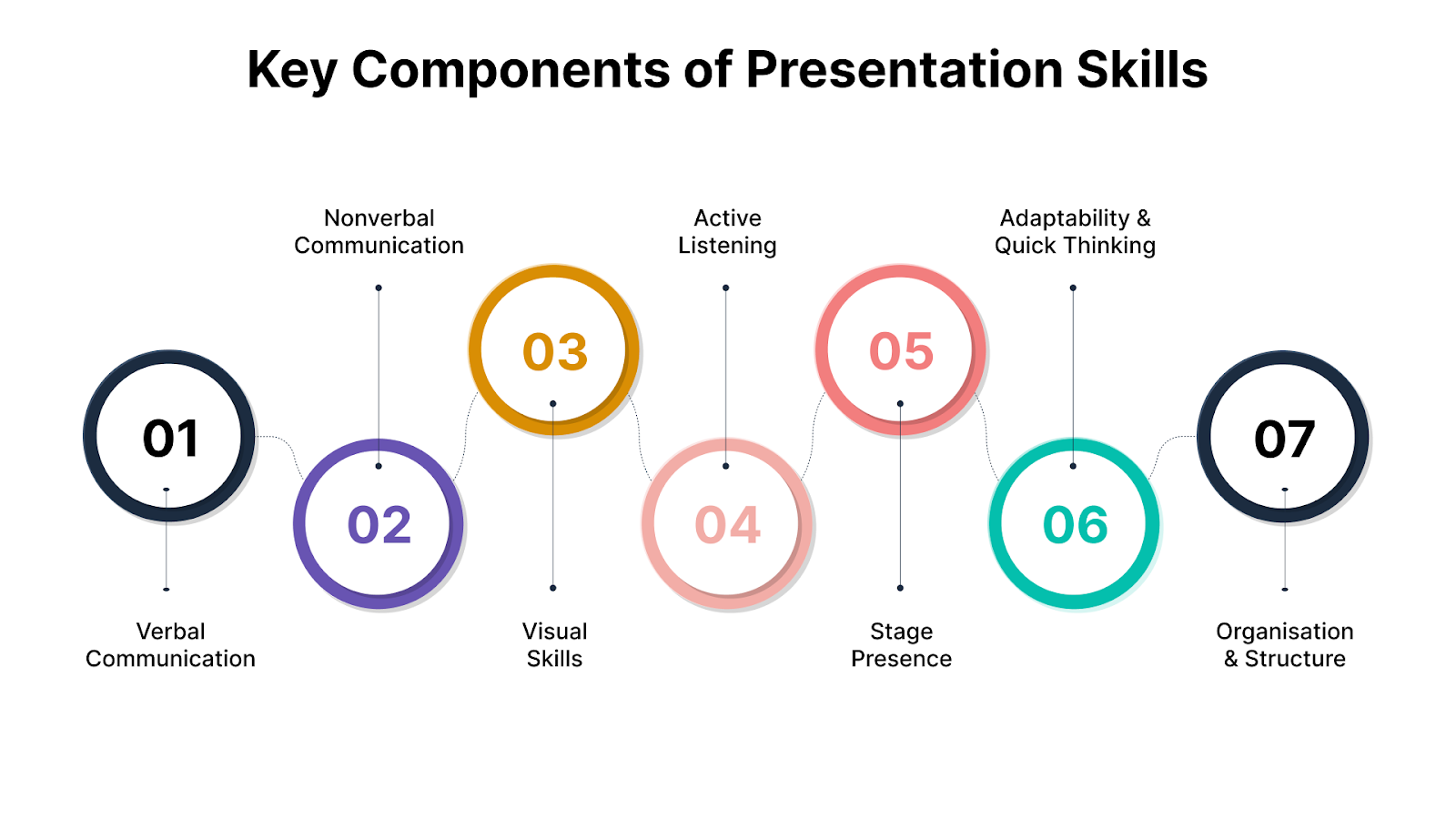Everyone’s seen it: one well-delivered slide can change a decision, win buy-in, or shift strategy. Presentations still carry serious weight, not because of the software, but because of the skill behind it.
Whether you’re leading meetings, pitching ideas, or aligning teams, your ability to present affects how your message is received and whether it drives action. A great presentation is about clarity, structure, timing, and reading the room.
Still, many professionals rely on outdated habits, such as reading slides, using cluttered visuals, or generically delivering their message, without realizing how much more impactful their presentation could be. Leadership quality ratings have dropped to just 40% in 2024, and leaders with strong interpersonal and presentation skills are 19 times more likely to earn top marks.
In this post, we’ll discuss the 11 most valuable presentation skills every professional should master, along with practical techniques to help engage any audience, communicate with impact, and drive real results.
What Are Presentation Skills?
Presentation skills are the abilities required to communicate information, ideas, or messages to an audience in a clear, engaging, and structured manner. These skills are essential for delivering effective presentations in various contexts, including meetings, conferences, and public forums.
They combine verbal, nonverbal, visual, and adaptive communication techniques to ensure your message is both understood and remembered

- Verbal Communication: Articulating thoughts clearly, using appropriate tone and pace, and articulating thoughts in a way that resonates with the audience.
- Nonverbal Communication: Using body language, facial expressions, gestures, and eye contact to reinforce your message and establish rapport with the audience.
- Visual Skills: Creating and utilising visual aids, such as slides, charts, or multimedia, to support and enhance your presentation.
- Active Listening: Paying attention to audience cues (both verbal and non-verbal) and adjusting your delivery in real time.
- Stage Presence: Developing confidence and a unique style that captures audience attention and maintains engagement.
- Adaptability and Quick Thinking: Handling unexpected questions, feedback, or technical issues promptly and clearly.
- Organisation and Structure: Planning your presentation logically to guide the audience through key points with clarity and impact.
Learning these elements improves presentation skills and builds confidence, credibility, and influence in every professional setting.
Why Are Good Presentation Skills Important?

Effective presentation skills do more than improve public speaking; they directly influence how professionals lead, collaborate, and drive impact within an organisation. Here’s how strengthening this skill set creates measurable value:
- Enhances Communication and Influence: Clear, persuasive delivery helps you explain complex ideas, align teams, and get support for your goals.
- Drives Engagement and Attention Span: Storytelling, expressive delivery, and well-designed visuals transform passive listeners into active participants. These techniques are highly effective in workshops, client presentations, and strategic discussions.
- Builds Credibility and Presence: Confident presenters earn the trust of their audience. When you speak with clarity and conviction, others listen, making you a more credible leader, department representative, or stakeholder liaison.
- Boosts Career Growth: Strong presentation skills set professionals apart. They signal leadership potential and are essential for promotions, executive roles, and cross-functional opportunities.
- Improves Confidence and Composure: While public speaking anxiety is common, it can be overcome through structured practice and training. Over time, presenters build poise, even in high-pressure scenarios.
- Sharpens Critical Thinking: Preparing a presentation requires clear thinking and a structured approach to messaging. This process enhances how you plan, analyse, and solve problems, not just how you speak.
Now that we’ve explored why presentation skills matter, let’s break down the 11 essential skills every professional should develop to present with clarity, confidence, and impact.
Top 11 Presentation Skills Every Professional Should Develop

Developing strong presentation skills is about being clear, confident, and engaging in any setting. Whether you're presenting to senior leaders, conducting a team meeting, or pitching an idea, these 11 core skills form the foundation of effective communication.
Learning them will help you deliver your message purposefully, connect with your audience, and achieve your objectives more consistently.
1. Clarity of Thought
Clear thinking is the foundation of every impactful presentation. Without it, even the most well-designed slides or confident delivery can fall flat. A structured thought process ensures your message is easy to follow, relevant to your audience, and aligned with your objectives.
Here's how to apply it:
- Define your core message: What should the audience remember or do after your presentation?
- Use logical frameworks: Apply structures like:
- Problem > Solution > Outcome (for pitches or proposals)
- What > Why > How (for process explanations or team briefings)
- Eliminate noise: Remove unrelated points, jargon, or excessive details that dilute the message.
- Sequence your ideas clearly: Move from general to specific or from issue to resolution.
For example, you're presenting a new internal workflow to a cross-functional team–
- Instead of saying: "We're revamping the onboarding process with some changes to forms, meetings, and IT handoffs…"
- You say: "Our current onboarding delays stem from uncoordinated handoffs. The new workflow introduces a central checklist and automated IT requests. This will reduce setup time by 40% and improve new joiner productivity within the first week."
Clarity of thought isn't just about what you say; it's about helping your audience understand it quickly and act confidently.
2. Audience Awareness
A great presentation speaks to the room it's in. That means shaping your message around what your listeners care about, not just what you want to say. Being audience-aware helps you build trust, relevance, and connection from the first slide.
How to develop this skill:
- Know your audience's roles and priorities: What matters to a finance lead might differ from what a product team needs.
- Adapt your tone and Examples: Use language that resonates with each group.
- Anticipate concerns: Address likely objections before they're raised.
For example, when presenting project updates to senior leadership, focus on the impact, return on investment (ROI), and alignment with strategic goals. With a team-level audience, emphasise day-to-day changes and how they benefit the workflow.
Audience awareness is about making people feel heard before you’ve even asked for their attention.
Also Read: Why Emotional Intelligence is Key in Leadership
3. Confident Body Language
Body language speaks before you do. In high-stakes presentations, whether in boardrooms, virtual meetings, or client pitches, your posture, gestures, and facial expressions can reinforce or undermine your credibility. Confident body language builds trust, shows leadership presence, and engages your audience.
Key ways to demonstrate it:
- Maintain steady eye contact: Shows focus and honesty. In virtual meetings, look into the camera occasionally to simulate connection.
- Stand or sit upright: Avoid slouching or swaying. An open posture signals confidence and control.
- Use purposeful hand gestures: Reinforce key points with measured, natural movements. Avoid fidgeting or crossing arms.
- Control facial expressions: Match your expression to the message, enthusiasm, seriousness, or empathy when appropriate.
- Own your space: In physical settings, avoid pacing. In virtual settings, frame yourself properly and keep movements calm.
For example, you're presenting a quarterly report to department heads. Instead of nervously looking at your notes and standing stiffly with crossed arms, you–
- Maintain an upright posture and open gestures
- Face your audience while speaking, nodding naturally to acknowledge key reactions
- Use your hands to emphasise performance improvements or risks
- Deliver with a steady voice and relaxed shoulders
These non-verbal cues signal control, confidence, and professionalism, qualities that elevate how your message is received, regardless of your seniority or role.
4. Effective Use of Visual Aids
Visuals should support your message, not overwhelm it. When done right, they support comprehension, highlight key data, and keep your audience engaged. Used poorly, they cause distraction and dilute the impact of your delivery.
Best practices for using visuals effectively:
- Keep slides clean and focused: One idea per slide; avoid dense text or overloading with charts.
- Use high-contrast colours and readable fonts: Ensure clarity for all viewers, especially in large rooms or virtual settings.
- Highlight key data: Use bolding, colours, or animation to draw attention, but sparingly.
- Limit animations and transitions: Overuse can feel gimmicky or unprofessional.
- Use graphs, diagrams, or icons: Simplify complex information visually.
For example, when presenting quarterly sales performance, instead of a spreadsheet screenshot, use:
- A bar graph showing performance by region
- Colour-coded arrows indicating YoY growth or decline
- A brief caption: “West region exceeded Q2 targets by 18% due to new partnerships.”
This helps your audience process data quickly and stay focused on what matters.
5. Leveraging AI Tools for Smarter Presentations
AI is rapidly transforming how professionals prepare and deliver presentations. From structuring your narrative to generating visuals and speaker notes, AI tools help you save time and increase impact, if used thoughtfully.
Smart ways to use AI in your presentation workflow:
- Content structuring: Use tools like ChatGPT to outline or refine talking points
- Slide design: Platforms like Tome and Beautiful.ai can auto-generate clean, branded slides
- Script writing and summarisation: Draft opening remarks or summarise data using prompt-based AI tools
- Data visualisation: Use AI features in Canva, PowerPoint, or Google Slides to enhance charts and layouts
- Presentation rehearsal: AI tools like Yoodli help you improve by analysing your speech for filler words, pacing, and clarity.
For example, you’re presenting a product roadmap. Instead of starting from scratch, you:
- Use ChatGPT to create a structured outline
- Import it into Tome to generate a visual-first slide deck
- Practice delivery using Yoodli to improve confidence and vocal pacing
If your organisation is looking to build practical AI skills, Corpoladder’s Prompt Engineering for ChatGPT course is designed to help professionals master the art of crafting effective prompts for a range of real-world applications.
This beginner-to-advanced programme covers prompt design fundamentals, advanced techniques, and practical use cases, enabling teams to improve the quality, relevance, and impact of ChatGPT outputs across business functions.
6. Vocal Delivery and Modulation
Your voice is a tool for emphasis, engagement, and clarity. Monotone delivery can lose attention, even with strong content. If every sentence sounds the same, with no rise, pause, or change in energy, your audience will start tuning out. Strategic vocal variation keeps listeners alert and signals confidence.
To strengthen your vocal delivery:
- Vary your tone: Use tone shifts to signal importance, enthusiasm, or urgency.
- Control your pace: Slow down to emphasise key points; avoid rushing through content.
- Pause intentionally: Pauses give your audience time to absorb information and can build anticipation.
- Avoid filler words: Practice removing “um,” “like,” or “you know” through rehearsed delivery.
- Ensure volume and clarity: Speak from the diaphragm and articulate clearly, especially in large or virtual spaces.
For example, during a virtual product demo, you can–
- Introduce the feature with a slightly upbeat tone
- Pause before revealing results: “And here’s what we found…”
- Drop your pace and volume slightly to emphasise: “Customer adoption increased by 27% within the first month.”
A well-modulated voice makes your message more persuasive, especially when addressing executives or external stakeholders. It shows you're in control and worth listening to.
7. Storytelling Techniques
Facts inform, but stories persuade. In the corporate setting, storytelling helps make data meaningful, aligns teams around shared goals, and makes your message memorable. A strong narrative structure keeps your audience emotionally and intellectually engaged.
Apply storytelling in presentations by:
- Using a narrative arc: Frame your message with context > conflict > and resolution
- Incorporating real examples: Use case studies, customer stories, or internal wins to ground your message
- Humanising the data: Tie metrics to people, outcomes, or decisions
- Setting stakes: Why does this matter now? What happens if we act, or don’t?
- Closing with insight: End with a lesson or takeaway that reinforces your main point
For example, instead of simply stating, “We reduced turnaround time by 32%,” say:
"When we received feedback from a key client about delayed support responses, we realised the process needed a rethink. By automating ticket assignment and reallocating our Tier 1 resources, we cut turnaround time by 32% in just eight weeks, regaining client trust and boosting our NPS by 12 points."
This approach helps internal stakeholders or decision-makers grasp your solution's logic and impact.
8. Handling Q&A with Confidence
Q&A sessions can either reinforce your credibility or unravel a well-structured presentation. Responding calmly and clearly to difficult or unexpected questions shows composure, subject mastery, and leadership readiness.
Tips to handle Q&A effectively:
- Listen fully: Don’t interrupt or rush to respond; clarify if needed
- Bridge difficult questions: Acknowledge the concern, then guide back to your main point or data
- Admit when you don’t know: Promise to follow up with the correct answer instead of guessing
- Involve the room: Invite others to build on your response when relevant
- Stay respectful and composed: Avoid defensive tones, even if challenged
For example, you’re presenting a policy change, and someone asks, “Why didn’t we pilot this with the customer support team first?”
A confident response would be: "That’s a fair point. We considered support as a starting point, but prioritised operations due to their existing automation readiness. That said, we’ve already scheduled a smaller rollout with support next quarter to compare adoption patterns. I’m happy to share those results once we have them."
Handling Q&A well reinforces trust, positions you as collaborative, and helps the conversation move forward constructively.
Employees who get candid feedback are 9X more likely to trust their managers, proof that clear, confident responses during Q&A pay off.
9. Time Management During Presentations
Running over time can dilute your message and leave a poor impression, especially in business settings with limited attention spans and tight schedules. Effective time management ensures that your key points are delivered clearly, without rushing or omitting essential details.
To manage time effectively during presentations:
- Set a clear agenda upfront: Give your audience a roadmap of what to expect and how long each section will take
- Prioritise your key messages: Lead with the most important insights, not background information
- Use timed rehearsals: Practice with a stopwatch to ensure pacing is realistic
- Include time for Q&A or discussion: Build in buffer time, especially in stakeholder meetings
- Use visual cues: Slide numbers or progress markers can help you (and your audience) stay on track
For example, you have 20 minutes to present a strategy update. Rather than diving into a 10-minute company history, you open with:
“In the next 20 minutes, I’ll walk you through the key changes in our regional rollout plan, the impact we’re seeing so far, and the three challenges we’re addressing next.”
This keeps the audience aligned and makes it easier to stay within time, even if questions arise.
If managing presentation time is an ongoing challenge, Corpoladder’s Productivity and Time Management course offers practical strategies to build lasting habits. This programme covers structured scheduling, task prioritisation, and productivity tools to enhance both individual efficiency and team output.
Through real business scenarios and expert-led workshops, professionals learn to stay organised, remain focused, and consistently deliver within time constraints, whether managing meetings, projects, or daily operations.
10. Persuasion and Influence
In many corporate settings, the goal of a presentation isn’t just to inform; it’s to drive a decision, secure buy-in, or motivate action. Persuasion is about aligning logic, emotion, and credibility to shift perspectives and prompt change.
To improve your influence as a presenter:
- Start with a clear objective: Know exactly what action or mindset shift you’re aiming for
- Back claims with evidence: Use data, case studies, or expert opinions to build authority
- Appeal to shared goals: Link your message to the audience’s KPIs or business outcomes
- Anticipate objections: Address likely pushback proactively with well-reasoned responses
- Use confident, active language: Replace vague phrases with firm recommendations
For example, you’re proposing a new internal tool. Instead of saying, “We think this might help improve efficiency,” you say:
“By implementing this tool, we can reduce processing errors by 35%, as seen in our pilot across two departments. This directly supports our Q3 target of faster turnaround and better compliance.”
This frames your recommendation with evidence and a clear link to business priorities, making your argument more compelling and actionable.
11. Feedback Integration and Continuous Improvement
No matter how experienced you are, there’s always room to refine your presentation style. The best professionals actively seek feedback on what went well and where they lost the room or missed the mark. Continuous improvement ensures you stay relevant, engaging, and effective over time.
Ways to integrate feedback and improve:
- Request structured feedback: Ask for input on clarity, engagement, timing, and delivery
- Review recordings: Analyse your tone, pacing, body language, and slide flow
- Track outcomes: Did your presentation lead to the intended action or decision?
- Create a personal improvement log: Note what worked, what didn’t, and how you adjusted.
- Attend peer presentations: Observe and learn from others in your organisation or industry.
For example, after a client pitch, you receive feedback that the financial section was perceived as rushed and overly technical. For the next presentation, you:
- Add one explanatory slide with simplified graphs
- Rehearse that section for pacing
- Ask a peer to review the clarity of your delivery
This cycle of learning and iteration builds a sharper, more audience-aware presentation style over time.
If improving communication in meetings, client presentations, or executive briefings is a priority, Corpoladder’s Communication and Presentation Skills course provides a structured pathway. This 35-hour programme combines real-world case studies, live practice sessions, and personalised feedback to develop public speaking, storytelling, and professional writing skills.
Through hands-on exercises aligned with workplace demands, participants learn to structure presentations, refine delivery, and build lasting confidence. Led by expert instructors, the course is designed for professionals across functions who aim to present with clarity, authority, and impact.
With the core skills outlined, here are some practical tips to help you apply and refine them in real-world settings.
Practical Tips and Techniques to Master Presentation Skills

You’ve nailed the content. Your slides are ready. But somehow, your delivery still doesn’t land the way you hoped. This is where technique makes the difference.
The tips below aren’t abstract theories; they’re practical, actionable methods you can use immediately. Test them, refine them, and incorporate them into your presentation toolkit.
Tip 1: Record and Review Your Presentations
One of the simplest yet most effective ways to improve your presentation skills is to record yourself. Most professionals prepare content but rarely evaluate how they deliver it. Watching your performance helps identify blind spots in tone, body language, pacing, and clarity, insights that are difficult to spot in the moment.
How to apply it:
- Use tools like Zoom, Microsoft Teams, or your phone camera to record practice sessions.
- Review the playback critically:
- Are you speaking too fast or using filler words?
- Do your visuals align with your speech?
- Is your body language open and confident?
- Make notes and iterate your delivery before presenting to stakeholders.
Example: Before presenting a quarterly update to leadership, record a mock version and review it with a colleague to ensure accuracy. You may notice that your key points are buried under excessive context. By tightening the narrative and pausing after each insight, you make the data more digestible and impactful.
Recording helps transform good presenters into great ones, not through guesswork, but through focused, self-led improvement.
Tip 2: Use the Rule of Three
Our brains are wired to recognise patterns, and grouping ideas in threes makes them stick better. Whether you're sharing benefits, challenges, or steps, breaking them into three points gives your message rhythm and clarity without overwhelming your audience.
How to apply it:
- When organising your talking points, limit each section to three key messages.
- Use verbal cues like “first,” “second,” and “finally” to guide the audience.
- Keep slide content aligned with your three-part structure.
Example: When pitching a new internal tool to your HR team, highlight three core benefits: time savings, employee satisfaction, and improved data accuracy. Your audience will walk away with a clearer, more memorable takeaway.
When you break things into threes, your message becomes more than information; it becomes something your audience can recall, repeat, and act on.
Tip 3: Practice Impromptu Speaking
Spontaneous speaking sharpens your thinking and boosts confidence, especially during Q&A sessions or unplanned discussions with leadership. Practicing it regularly can help you sound composed and credible, even without slides in front of you.
How to apply it:
- Set a timer and speak for two minutes on a random topic, no prep allowed.
- Join a Toastmasters club or similar speaking group.
- Practice explaining complex ideas to non-experts in simple language.
Example: Before a client call, rehearse how you'd explain your service in 60 seconds if the call got cut short. This exercise helps you develop your ability to stay sharp and concise under pressure.
Spontaneous speaking isn’t about winging it. It’s about building the reflexes to think, speak confidently, and lead conversations that count.
Tip 4: Apply the Pyramid Principle
The Pyramid Principle helps structure your message for clarity. Lead with your key point, then support it with relevant arguments. It ensures your audience gets the main idea immediately, which is crucial when time is limited.
How to apply it:
- Start with your conclusion or recommendation.
- Follow with grouped supporting points, each with its sub-points.
- Use this structure for emails, slide decks, and even verbal updates.
Example: While briefing your L&D manager, say, “We should adopt Tool X for training; here’s why. " Then, outline cost-effectiveness, user feedback, and deployment ease. You lead with value, not background noise.
Tip 5: Build a Personal Story Bank
Relatable stories humanise your presentations. Having a ready stash of personal anecdotes makes it easier to connect emotionally with your audience, explain complex ideas, and keep people engaged.
How to apply it:
- Jot down moments from your career: wins, lessons, failures, and turning points.
- Tag each story by theme (e.g., leadership, problem-solving, innovation).
- Practice integrating them into your presentations for relevance.
Example: While speaking about team communication, share a short story about when a misread email escalated into confusion, and how a five-minute video call cleared it all up. Suddenly, the concept becomes authentic and memorable.
Tip 6: Engage with Micro-Interactions
Modern presentations, especially virtual ones, need audience participation. Micro-interactions, such as polls or open-ended questions, keep energy levels up, make your talk feel two-way, and increase attention span.
How to apply it:
- Use tools like Mentimeter, Slido, or Zoom polls to involve your audience.
- Plan moments to ask quick check-ins like, “How many of you have faced this?”
- Follow up interactions with comments or visuals that build on their responses.
Example: During a training session, run a poll asking how confident participants feel about using a new tool. Use the results to adjust your pace or revisit unclear sections, making the session more adaptive and inclusive.
Tip 7: Follow the “10-20-30” Rule for Slides
Guy Kawasaki coined the “10-20-30” rule, which keeps slide decks tight and effective: no more than 10 slides, lasting no more than 20 minutes, and using at least a 30-point font. This rule forces clarity and avoids information overload.
How to apply it:
- Limit each slide to one key idea or visual.
- Keep text minimal, use bold phrases, not paragraphs.
- Use large fonts to ensure readability across devices or rooms.
Example: When preparing a project proposal, cut your 18-slide deck down to 10 by focusing on the problem, solution, and impact. You’ll come across as sharper, more prepared, and respectful of your audience's time.
Simplicity signals confidence. When your slides are crisp and focused, your ideas take center stage, and your message lands stronger.
While individuals can apply these techniques independently, lasting impact across teams comes from structured, organisation-wide training.
How Organisations Can Develop These Skills at Scale with Corpoladder?
Strengthening communication and presentation skills at scale requires practical, flexible programs that are aligned with real business needs. Corpoladder supports this through a wide range of training solutions tailored for diverse industries and skill levels.
Here’s why organisations partner with Corpoladder:
- Expert-led instruction: Delivered by seasoned trainers with deep industry and corporate training experience
- Applied learning formats: Programmes include hands-on activities, real-time feedback, and business-relevant scenarios to strengthen workplace communication
- Customised training solutions: Our team works closely with you to design sessions that address your organisation’s unique challenges and goals
- Flexible delivery options: Choose from in-person workshops, live virtual classes, or self-paced e-learning, adaptable across teams and geographies
- Cross-domain expertise: Training across AI, ESG, and Leadership ensures your teams build communication skills that support broader business priorities
Organisations that blend five or more learning methods are 4.9× more likely to improve leadership capabilities, exactly the multi-modal approach Corpoladder uses. Corpoladder helps organisations build teams that communicate, present with confidence, and contribute more effectively to long-term goals.
Also Read: How to build a thriving and happy corporate culture by using corporate training via Corpoladder
Conclusion
Strong presentation skills are no longer optional; they’re a professional necessity. From delivering key updates to influencing strategic decisions, your ability to communicate with clarity, confidence, and purpose directly impacts how your message is received. By developing core competencies and applying practical techniques, every professional can become a more compelling presenter.
At Corpoladder, we help organisations build these capabilities at scale. Through expert-led training programmes, tailored learning formats, and real-world application, we equip your workforce with the skills they need to lead with clarity and influence. Get in touch to see how we can help your teams present more effectively in any setting.
FAQs
Q1: How can I overcome the fear of public speaking?
Fear of public speaking, commonly known as glossophobia, is a widespread challenge among professionals. The best way to manage this anxiety is through consistent preparation and rehearsal. Visualising a successful delivery can help build confidence, while regular practice reduces nervousness. Incorporating mindfulness techniques, such as deep breathing or grounding exercises, can help you remain calm and focused before and during your presentation.
Q2: What are some effective ways to engage my audience during a presentation?
Audience engagement is critical for delivering a memorable and effective presentation. Use tools like Mentimeter or Slido to incorporate interactive elements such as live polls or open-ended questions. Storytelling, through relevant anecdotes or case studies, can also make your message more relatable. Complement your content with impactful visuals and maintain strong body language, like eye contact and open gestures, to build a stronger connection with your audience.
Q3: How can I improve my vocal delivery during presentations?
A well-controlled voice significantly enhances your message. Modulate your tone to highlight key points and adjust your pace to maintain clarity. Pauses are proper for emphasis and give your audience time to absorb the information. To maintain attention and authority, ensure you project your voice clearly and at an appropriate volume, especially in larger rooms or virtual settings.
Q4: What should I do if I don't know the answer to a question during the Q&A session?
Not having an immediate answer is perfectly acceptable, provided it is handled professionally. Acknowledge the question honestly and offer to follow up with the correct information after the session. If relevant, you can also redirect the question to a colleague or expert in the room. Most importantly, stay composed and courteous, demonstrating credibility and calm under pressure.
Q5: How can I use AI tools to enhance my presentations?
AI can significantly improve your presentation process. Use tools like ChatGPT to brainstorm content, structure ideas, or refine key messaging. For design, platforms such as Canva or Tome can help you create visually polished slides quickly. To maintain professional language and tone, applications like Grammarly or Writer can support grammar checks and stylistic improvements, ensuring your presentation reads clearly and persuasively






.webp)











